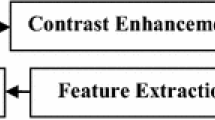Abstract
The existence of defects is a key factor for quality degradation of float glass. This paper introduces an approach of glass defect identification based on multiresolution and information fusion analysis. With the help of 2D discrete wavelet transform, the subtracting defect image with a valid region is decomposed into approximated subimages and detailed subimages. The approximated subimages in three-level scales and the original defect image are chosen to proceed recognition with artificial neural network and fuzzy k-nearest neighbor. The decisive vectors from four classifiers are fused by an improved Dempster–Shafer (DS) evidence theory with head difference calibration-DS. Besides, a twice OTSU segmentation method as well as ten statistic features are interpreted for the preparation of defect recognition. The results of application indicate that the proposed algorithm can significantly increase the correct recognition rate of glass defects in five classes.
Similar content being viewed by others
References
Shang H, Chen Y, Wenyong Yu, Zhou Z (2007) Online auto-detection method and system of presswork quality. Int J Adv Manuf Technol 33:756–765
Chiou Y-C, Li W (2009) Flaw detection of cylindrical surfaces in PU-packing by using machine vision technique. Measurement 42(7):989–1000
Killing J, Surgenor BW, Mechefske CK (2009) A machine vision system for the detection of missing fasteners on steel stampings. Int J Adv Manuf Technol 41:808–819
Cios KJ, Langenderfer RA, Tjia R, Liu N (1991) Recognition of defects in glass ribbons using neural networks. IEEE Proceedings of NSF Design and Manufacturing System. SME Publication, Dearborn, pp 203–206
Bartl J, Fíra R, Hain M (2001) Inspection of surface by the moiré method. Meas Sci Rev 1(1):29–32
Heredia-Ortiz M, Patterson EA (2003) On the industrial applications of moiré and fringe projection techniques. Strain 39:95–100
Park JH, Lee SB (2007) High resolution AFM moiré technique for the detection of defects in nano structure. International Conference on Electronic Materials and Packaging, pp 1–4
Cios KJ, Tjia R, Liu N, Langenderfer RA (1991) Study of continuous ID3 and radial basis function algorithms for the recognition of glass defects. In: International Joint Conference on Neural Networks Seattle, 8–9 July 1991. IJCNN91 vol 1. IEE, New York, pp 49–54
Fezani F, Rahmani A (2001) Wavelet analysis for defects detection in flat glass. IMACS Multiconference on Computational Engineering in Systems Applications, pp 132–139
Müller H, Strubel C, Bange K (2001) Characterization and identification of local defects in glass. Scanning 23(1):14–23
Peng X, Chen Y, Wenyong Yu (2008) An online defects inspection method for float glass fabrication based on machine vision. Int J Adv Manuf Technol 39:1180–1189
Pohl C, Van Genderen JL (1998) Multisensor image fusion in remote sensing: concepts, methods and applications. Int J Remote Sens 19(5):823–854
Guo R, Pandit SM (1998) Automatic threshold selection based on histogram models and a discriminant criterion. Mach Vis Appl 10:331–338
Mallat S (1989) A theory for multiresolution signal decomposition. IEEE Trans Pattern Anal Mach Intell 11:674–693
Grossmann A, Morlet J (1984) Decomposition of Hardy functions into square integrable wavelets of constant shape. SLAM J Math 15:723–736
Stollnitz EJ, DeRose TD, Salesin DH (1995) Wavelets for computer graphics: a primer, part 1. IEEE Comput Graph Appl 15(3):76–84
Pontes FJ, Ferreira JR, Silva MB, Paiva AP, Balestrassi PP (2010) Artificial neural networks for machining processes surface roughness modeling. Int J Adv Manuf Technol 49:879–902
Wu X, Zhou J (2005) Kernel-based fuzzy k-nearest-neighbor algorithm. In: Proceedings of the 2005 International Conference on Computational Intelligence for Modelling, Control and Automation, and International Confentelligent Agents, Web Technologies and Internet Commerce (CIMCA-IAWTIC’05), (28–30):159–162
Hou G, Zhang J, Zhou J (2002) Mixture of experts of ANN and KNN on the problem of puzzle 8. Technical report, Computing Science Department University of Alberta. IPC. 2008. International planning competition. http://ipc.informatik.uni-freiburg.de. Accessed 14 November 2002
Feng GC, Yuen PC, Dai DQ (2000) Human face recognition using PCA on wavelet subband. SPIE J Electron Imaging 9(2):226–233
Author information
Authors and Affiliations
Corresponding author
Rights and permissions
About this article
Cite this article
Liu, Hg., Chen, Yp., Peng, Xq. et al. A classification method of glass defect based on multiresolution and information fusion. Int J Adv Manuf Technol 56, 1079–1090 (2011). https://doi.org/10.1007/s00170-011-3248-z
Received:
Accepted:
Published:
Issue Date:
DOI: https://doi.org/10.1007/s00170-011-3248-z




